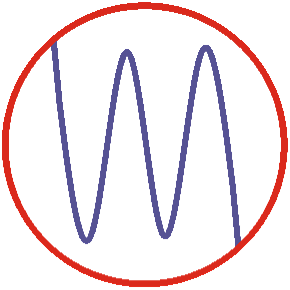Accurately Calculate Lithium Bromide Concentration, Assess Crystallisation Risks, and Determine Inhibitor Requirements for Enhanced Absorption Chiller Efficiency
Introduction: Why Monitoring Lithium Bromide Absorption Chillers Matters
Lithium Bromide (LiBr) absorption chillers are widely used in hospitals, data centres, and industrial plants, leveraging waste heat, steam, or hot water to generate chilled water.
Even minor deviations in concentration or operating temperatures can cause:
- ⚠ Crystallisation, blocking heat exchangers and causing downtime
- ⚠ Reduced performance (COP), wasting energy for less cooling
- ⚠ Shortened equipment life and higher maintenance costs
Vamtec’s Absorption Chiller Calculators provide a fast, accurate, and actionable way to:
- Validate chiller design
- Predict crystallisation risk
- Optimise efficiency and COP
- Troubleshoot underperforming systems
⚡ Time-saving & cost-saving: Stop guesswork, prevent downtime, and improve ROI instantly.
| Calculator | Purpose | Key Inputs | Quick Benefit |
| Lithium Bromide Calculator | Calculate Inhibitor and alkalinity correction chemicals | Inhibitor and alkalinity level, LiBr concentration, specific gravity and quantity | Correct LiBr properties and prevent internal corrosion |
| Concentration Calculator | Calculate LiBr and refrigerant concentration | Lithium Bromide temperature, specific gravity, condensed refrigerant and generator temperature. | Optimizes Solution Concentration and efficiency, prevent crystallisation |
| Performance Calculator | Calculate Heat Balance & COP of Absorption Chiller and Heat Pump | Application, measurement system, flow and temperature | Optimise energy and system efficiency, Facilitates Troubleshooting and quick diagnostics. |
1. Lithium Bromide Absorption Chiller Calculator
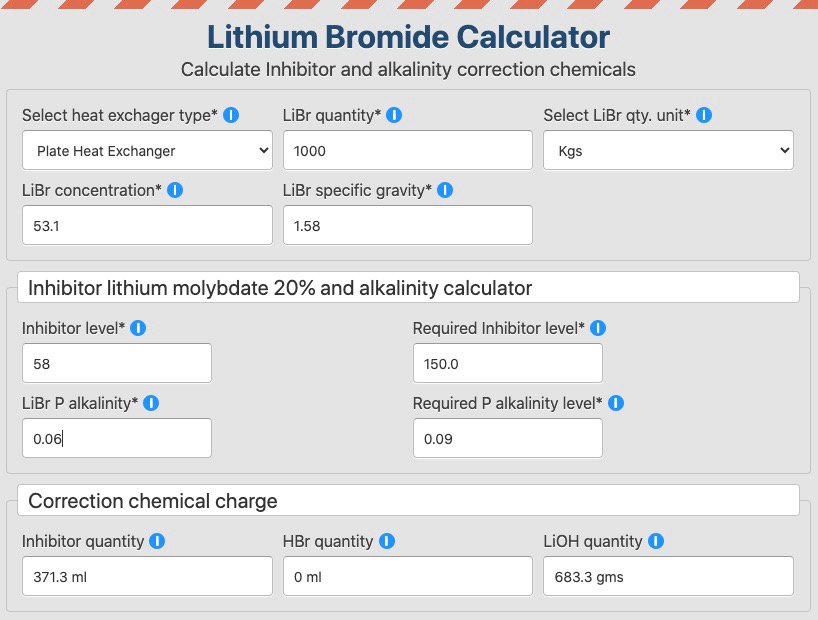
The LiBr Calculator calculates inhibitor and alkalinity correction chemicals for single-effect and double-effect absorption chillers.
Step-by-Step Use:
- Select the Heat Exchanger type: Some absorption chillers are supplied with plate type heat exchangers, and some are with shell and tube heat exchangers. Typically, PHE are made with SS plates and STHE are made with copper tubes
- Lithium Bromide Quantity: Enter LiBR quantity in Kgs or Lbs and select the appropriate unit
- Enter LiBr Concentration and specific gravity
- Enter Inhibitor and alkalinity level as per the LiBr analysis report
- Adjust inhibitor and alkanity level, if required
- Review the output
Example Output: Required correction chemicals including Inhibitor, HBr, and LiOH quantity.
✅ Ensures safe operation, prevents downtime, and extends equipment life.
2. Absorption Chiller Concentration Calculator
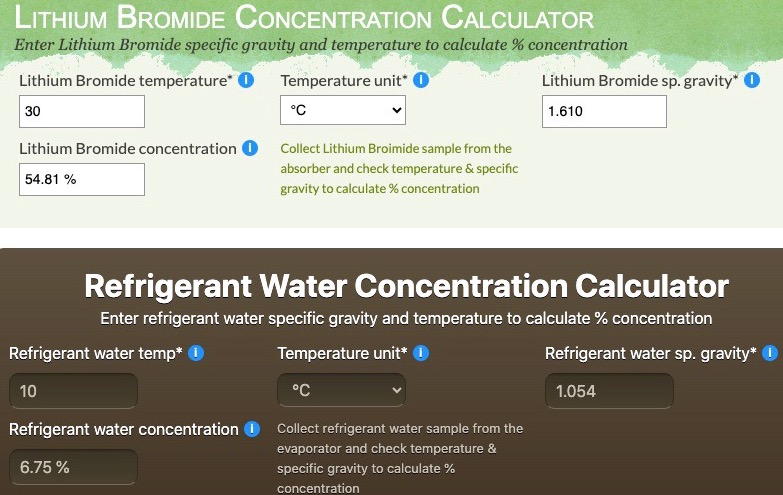
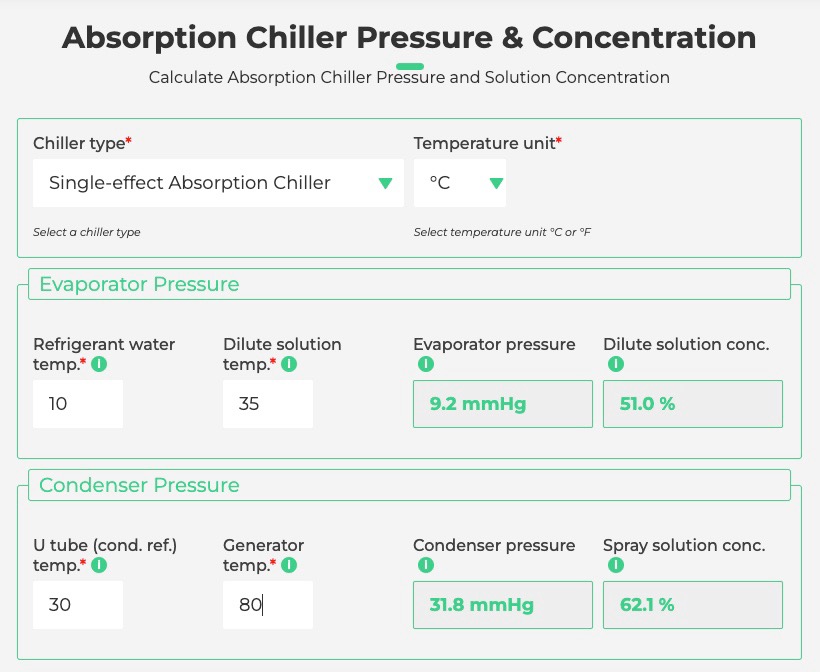
Why Concentration Matters:
- Too weak → Poor absorption, reduced cooling capacity
- Too strong → Risk of crystallisation, potential shutdowns
- Monitoring range: 55–60% single-effect, 58-63% double-effect
Quick Reference Table: Safe Ranges vs COP Impact
| LiBr Concentration | System Type | Performance Impact |
| 55–60% | Single effect | Optimal COP & efficiency |
| 58–63% | Double-effect | Typical operation, safe |
| >64% | Any | ⚠ High crystallisation risk |
| <50% | Any | ⚠ Weak solution, poor cooling |
Step-by-Step Use (LiBr concentration calculator):
- Collect the Lithium Bromide Sample from the absorber
- Find the lithium bromide temperature and specific gravity. The temperature can be entered either in °C or °F
- Enter the values in the lithium bromide concentration calculator
- Review the output
Step-by-Step Use (Refrigerant Water concentration calculator):
- Collect refrigerant water sample from evaporator of the chiller
- Find the refrigerant water temperature and specific gravity. The temperature can be entered either in °C or °F
- Enter the values in the refrigerant water concentration calculator
- Review the output
Step-by-Step Use (Pressure and concentration):
- Here, you can select to apply the calculator to single or double effect chiller
- Take the refrigerant water temperature and dilute solution temperature. Enter the value under evaporator pressure section
- Under the condenser pressure section, enter the condensed refrigerant (U-tube) and generator temperature
- The results you will get are Evaporator pressure, dilute solution concentration, condenser pressure, and spray solution concentration
⚡ Fast, actionable insight without lab tests or outdated charts
3. Performance Calculator: COP & Efficiency
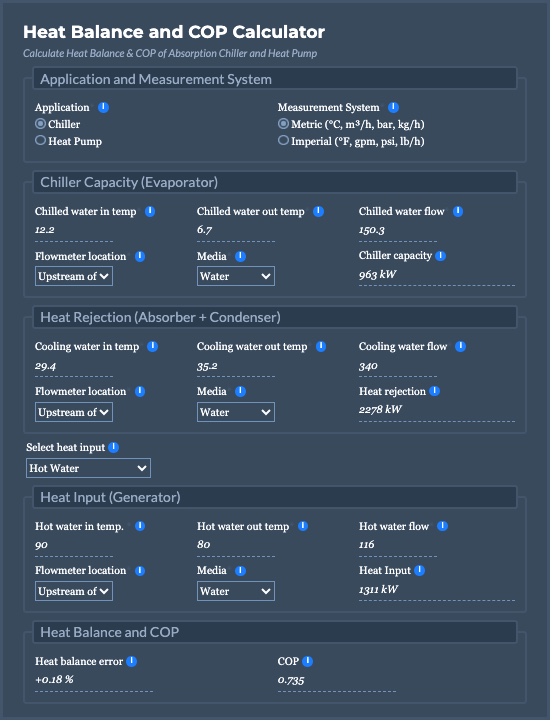
In this performance calculator, you can select:
- Chiller or Heat Pump Application
- Metric or imperial measurement system
- Upstream of inlet or downstream of outlet flowmeter location
- Media type of water, Ethylene Glycol or Propylene Glycol
- Heat input of steam, hot water, exhaust gas or direct fired
Efficiency drives ROI and energy savings. The Performance Calculator estimates:
- COP (Coefficient of Performance)
- Heat Balance Error (%)
- Chiller capacity (kW)
- Heat Rejection (kW)
- Heat Input (kW)
Factors Affecting Performance:
- Heat source temperature (higher improves COP)
- Ambient conditions (hotter condensers reduce efficiency)
- Scaling and fouling (dirty heat exchangers lower COP)
- Hot Water Temperature/Steam Pressure (Higher improves COP)
Comparison with Mechanical Chillers:
- ✅ Saves energy using waste heat
- ✅ Reduces peak electricity demand
- ❌ Typically lower COP at small scale
Helps quantify savings, determine hybrid upgrades, and plan ROI.
Real-World Case Studies
Common Mistakes Engineers Make
- ❌ Using outdated charts instead of validated calculators
- ❌ Over-concentrating solutions, increasing crystallisation risk
- ❌ Ignoring LiBr properties
- ❌ Not checking part-load conditions
The calculators prevent these errors with real-time, scenario-specific guidance.
FAQ & Integration
Q: Can it replace lab tests?
A: Reliable for operational checks, periodic lab analysis still recommended
Q: Safe LiBr concentration?
A: 55–63%, risk rises >63%
Q: Can it calculate COP?
A: Yes, for single-effect & double-effect systems
Q: IoT integration possible?
A: Yes, automate monitoring, alerts, and data logging
Q: Suitable for ammonia chillers?
A: No — LiBr/water systems only
Call-to-Action: Run the Calculators & Optimise Your System
Stop guessing or waiting weeks for lab results. Protect assets, prevent downtime, and improve efficiency with real-time insights.
👉 Run the Lithium Bromide Absorption Chiller Calculator
👉 Run the Absorption Chiller Concentration Calculator
👉 Run the Performance Calculator
🔬 Consult Vamtec for commissioning, full design validation, or feasibility studies.
Knowledge is uptime — now at your fingertips.
